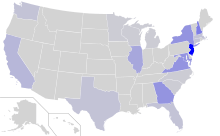Sindhi Americans
Sindhi Americans are Americans or residents of the United States who are of Sindhi descent.[lower-greek 1] They are a subgroup of Pakistani Americans and Indian Americans.[2]
| Total population | |
|---|---|
| 6,907 (2010 US Census)[1] Other estimates: 50,000[2] | |
| Regions with significant populations | |
| New York · New Jersey · California · New Hampshire · Texas · Illinois · Georgia · Virginia · Maryland · Florida · Washington · other states | |
| Languages | |
| English · Sindhi · Hindi-Urdu | |
| Religion | |
| Islam · Hinduism | |
| Related ethnic groups | |
| Sindhi diaspora · Pakistani Americans · Indian Americans · Indian diaspora · Pakistani diaspora |
Demographics

Originating from the Sindh region of Pakistan, most Sindhi Americans are Muslim. Some belong to the Hindu faith, particularly those who migrated from India.[2] In the 2010 US Census, nearly 7,000 individuals reported Sindhi as their first language.[1] The total population of the Sindhi diaspora in the United States is estimated at over 50,000. The community is spread out over various U.S. cities, with sizable populations on the eastern coast.[3]
Culture
Sindhi festivals such as Cheti Chand are celebrated each year with much fanfare.[4] The American Institute of Sindhulogy (AIS) is a non-profit institute of Sindhology in the U.S., dedicated to researching the history and cultural heritage of Sindh as well as its ancient Indus Valley Civilisation.[5]
Organizations and politics
Sindhi Americans are socially and politically active, having formed numerous community and political-oriented organizations. They maintain interest in domestic American politics, as well as Sindhi politics and the wider politics of Pakistan.[6] The Pakistan Peoples Party has a local chapter in the U.S., in which many Sindhis are involved.[7][8] The World Sindhi Institute is a human rights organization founded in 1997 and is based in Washington, D.C.[6] The World Sindhi Congress (WSC) has a U.S chapter which participates in human rights advocacy and the promotion of Sindhi political interests among the diaspora.[9] G. M. Syed Memorial Committee is a group based in Houston, which promotes the ideology of Sindhi nationalist leader G.M. Syed.[10][3] There are also Congress-focused lobbying groups such as the Sindhi American Political Action Committee (SAPAC),[11] and the Sindh Monitor.[2]
In addition, there are multiple community organizations and associations. The Sindhi Association of North America (SANA) is one of the largest societies of Sindhis residing in North America.[12][13] Other Sindhi associations include the American British Sindhi Medical Network (ABSMN),[14] and the Alliance of Sindhi Associations of Americas which consists of various state-based associations.[15]
Notable people
| Lists of Americans |
|---|
| By U.S. state |
| By ethnicity or nationality |
|
|
|
|
|
|
|
|
|
- Ali S. Asani, academic
- Sabeer Bhatia, entrepreneur and founder of Hotmail[16]
- Abdul-Majid Bhurgri, computer scientist
- Neeraj Khemlani, journalist
- Raj Kiran Mehtani, Bollywood actor
- Rajesh Mirchandani, television journalist
- Rajeev Motwani, computer scientist
- Sunita S. Mukhi, performance artist and cultural producer
- Kumail Nanjiani, actor and stand-up comedian
- Safdar Sarki, political activist
- Sachal Vasandani, jazz singer
- Reetika Vazirani, poet and educator
- Umesh Vazirani, computer scientist
- Vijay Vazirani, computer scientist
See also
Notes
- Sindhi: سنڌي آمريڪي (Arabic); सिन्धी अमेरिकन (Devanagari)
References
- "US Census 2010 (see row# 69)". U.S. Census Bureau.
Table 1. Detailed Languages Spoken at Home and Ability to Speak English for the Population 5 Years and Over for the United States: 2006-2008
- Chatterji, Joya; Washbrook, David (2014). Routledge Handbook of the South Asian Diaspora. Routledge. ISBN 9781136018244.
- "Hundreds of Sindhi-Americans Gathered in Houston to Pay Tribute to Their National Leader". World Sindhi Congress. 17 January 2011. Retrieved 12 May 2014.
- "Cheti Chand Celebrations April 2nd, 2016". Sindhi Association of Metropolitan Chicago. Retrieved 3 August 2016.
- "Homepage". American Institute of Sindhulogy. Retrieved 12 May 2014.
- Syed, Wajid Ali (3 July 2012). "Sindhi organisations issue 10-point declaration in US". The News International. Retrieved 11 May 2014.
- "Welcome to Pakistan Peoples Party USA Official Web Site". Pakistan Peoples Party (USA). Retrieved 12 May 2014.
- "The Official Website of Pakistan Peoples Party - USA". Pakistan Peoples Party (USA). Retrieved 12 May 2014.
- Ghosh, Papiya (2014). Partition and the South Asian Diaspora: Extending the Subcontinent. Routledge. p. 111. ISBN 9781317809661.
- "Work & Life of G. M. Syed". GMSyed.org. Retrieved 12 May 2014.
- "Homepage (archived from Wayback)". SAPAC. Archived from the original on 3 January 2014. Retrieved 11 May 2014.CS1 maint: BOT: original-url status unknown (link)
- "Welcome to Sindhi Association of North America". SANALIST. Archived from the original on 11 July 2010. Retrieved 11 May 2014.
- "Home". SANA. Retrieved 11 May 2014.
- "Home". American British Sindhi Medical Network. Retrieved 12 May 2014.
- "Homepage". Global Sindhi Association. Retrieved 3 August 2016.
- Sakhrani, Tarun (4 January 2016). "The Sindhis of Sindh And Beyond". Huffington Post. Retrieved 9 August 2016.
